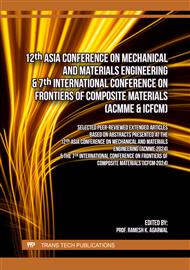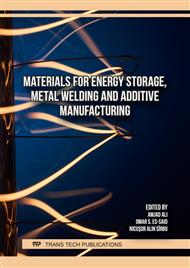[1]
Panmongkol, P., & Phung-on, I. (2021). Effect of backing gas mixtures on corrosion properties of stainless steel grade 304 weld metal by autogenous GTAW. Journal of Materials Research and Technology, 11, 1559–1570.
DOI: 10.1016/j.jmrt.2021.01.125
Google Scholar
[2]
Westin, E., Johansson, M. and Pettersson, R., 2013, "Effect of nitrogen-containing shielding and backing gas on the pitting corrosion resistance of welded lean duplex stainless steel LDX 2101® (EN 1.4162, UNS S32101)", Weld World, Vol. 57, pp.467-476.
DOI: 10.1007/s40194-013-0046-2
Google Scholar
[3]
Pamuk, S. and Sojiphan, K,. 2018, "Effects of argon-nitrogen backing gas ratios on microstructure and corrosion resistance of duplex stainless steel pipe ASTM A790 welds by gas tungsten arc welding process", Materials Today Proceedings, Vol. 5, pp.9512-9518.
DOI: 10.1016/j.matpr.2017.10.132
Google Scholar
[4]
Chuaiphan, Wichan; Srijaroenpramong, Loeshpahn (2012). The Behavior of Nitrogen on the Welding Parameters of the Dissimilar Weld Joints between AISI 304 and AISI 316L Austenitic Stainless Steels Produced by Gas Tungsten Arc Welding. Applied Mechanics and Materials, 248, 395–401.
DOI: 10.4028/www.scientific.net/amm.248.395
Google Scholar
[5]
AWS C5.5, recommended practices for gas tungsten arc welding. American Welding Society; 2003.
Google Scholar
[6]
Li, Yan Li; Xiang, Song; Zeng, Hong Tao; Wang, Jiang Ping; Wang, Quan Ding (2011). The Corrosion Behavior of 304L and 316L Stainless Steel in Food Grade Phosphoric Acid Solutions. Applied Mechanics and Materials, 109, 28–31.
DOI: 10.4028/www.scientific.net/AMM.109.28
Google Scholar
[7]
Aghababaie, E., Javadinejad, H. R., Saboktakin Rizi, M., & Ebrahimian, M. (2017). Effect of Chlorine Ion on the Corrosion of 316L Austenitic Stainless Steel. Advanced Engineering Forum, 23, 1–12.
DOI: 10.4028/www.scientific.net/aef.23.1
Google Scholar
[8]
Lu, Jan Shu; Lu, Qin Song; Xue, Jin (2014). Corrosion Resistance of Three 316 Stainless Steels. Advanced Materials Research, 936, 1097–1101.
DOI: 10.4028/www.scientific.net/AMR.936.1097
Google Scholar
[9]
Yan, S., Shi, Y., Liu, J., & Ni, C. (2019). Effect of laser mode on microstructure and corrosion resistance of 316L stainless steel weld joint. Optics & Laser Technology, 113, 428–436
DOI: 10.1016/j.optlastec.2019.01.023
Google Scholar
[10]
Chandra-Ambhorn, Somrerk; Chauiphan, Wichan; Sukwattana, Nich Chanuch; Pudkhunthod, Narin; Komkham, Sakarat (2012). Plasma Arc Welding between AISI 304 and AISI 201 Stainless Steels Using a Technique of Mixing Nitrogen in Shielding Gas. Advanced Materials Research, 538-541(), 1464–1468.
DOI: 10.4028/www.scientific.net/AMR.538-541.1464
Google Scholar
[11]
Kostina, M. V., Bannykh, O. A., & Blinov, V. M. (2000). Metal Science and Heat Treatment, 42(11/12), 459–462.
DOI: 10.1023/a:1010479914464
Google Scholar
[12]
Baghdadchi, A., Hosseini, V. A., Hurtig, K., & Karlsson, L. (2020). Promoting austenite formation in laser welding of duplex stainless steel—impact of shielding gas and laser reheating. Welding in the World, 65(3), 499–511.
DOI: 10.1007/s40194-020-01026-7
Google Scholar
[13]
Baba, H., Kodama, T., & Katada, Y. (2002). Role of nitrogen on the corrosion behavior of austenitic stainless steels. Corrosion Science, 44(10), 2393–2407.
DOI: 10.1016/s0010-938x(02)00040-9
Google Scholar
[14]
Pan, Y., Chen, R. F., Wang, D. X., Cai, G. S., Zhang, X. L., & Liu, T. (2012). Research on the Failure Mechanism of Pitting Corrosion of the 304 Stainless Steel in Chloride Ions Environment. Advanced Materials Research, 502, 12–16.
DOI: 10.4028/www.scientific.net/amr.502.12
Google Scholar
[15]
Welding Metallurgy and Weldability of Stainless Steels. John C. Lippold, Damian J. Kotecki. ISBN: 978-0-471-47379-4 April 2005.
Google Scholar
[16]
Maruschak, P., Konovalenko, I., Guzanová, A., Sydor, P., & Panin, S. V. (2015). Defectometry Analysis of Surface Condition Damaged with Corrosion Pitting. Materials Science Forum, 818, 153–157.
DOI: 10.4028/www.scientific.net/msf.818.153
Google Scholar



